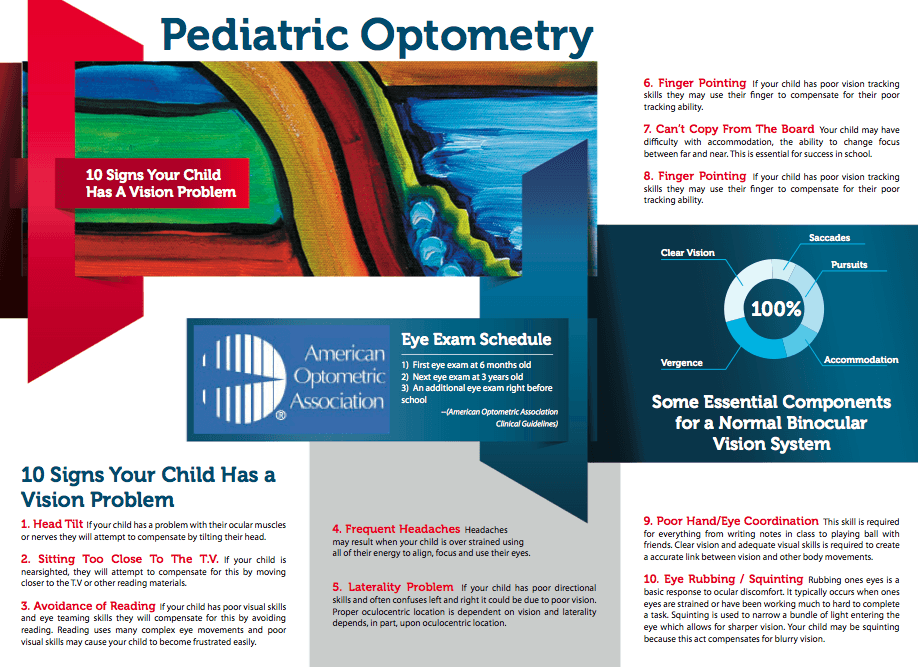I recently was studying some common vision problems that occur in children and the signs and symptoms associated with these problems. I realized that as a profession, we can raise significant awareness about vision problems so long as we provide the right messaging to our patients. With that being said, I decided to create this brochure “10 Signs Your Child May Have a Vision Problem”.
Here is the link to download the brochure Pediatrics Brochure OS
Pediatric vision exams are crucial for preventing future scholastic and functional problems. Unfortunately, this necessity is often overlooked, as parents have many responsibilites with young children. As student clinicians, we can help foster awareness of the importance of eye exams in this special population and educate parents about vision development in their children. Included is a brochure outlining specific signs and symptoms of visual dysfunction as well as an informative summary of research.
You can easily print the brochure, double-sided, as color or black and white and give it to the parents of your pediatric patients. They will appreciate the information and it’s an excellent way to distinguish yourself as a student clinician. Click the image to download the brochure. It’s tri-fold and looks great when printed!
1. Head Tilt If your child has a problem with their ocular muscles or nerves they will attempt to compensate by tilting their head.
2. Sitting Too Close To The T.V. If your child is nearsighted, they will attempt to compensate for this by moving closer to the T.V or other reading materials.
3. Avoidance of Reading If your child has poor visual skills and eye teaming skills they will compensate for this by avoiding reading. Reading uses many complex eye movements and poor visual skills may cause your child to become frustrated easily.
4. Frequent Headaches Headaches may result when your child is over strained using all of their energy to align, focus and use their eyes.
5. Laterality Problem If your child has poor directional skills and often confuses left and right it could be due to poor vision. Proper oculocentric location is dependent on vision and laterality depends, in part, upon oculocentric location.
6. Finger Pointing If your child has poor vision tracking skills they may use their finger to compensate for their poor tracking ability.
7. Can’t Copy From The Board Your child may have difficulty with accommodation, the ability to change focus between far and near. This is essential for success in school.
8. Squinting Squiting is used to narrow a bundle of light entering the eye which allows for sharper vision. Your child may be squinting because this act compensates for blurry vision.
9. Poor Hand/Eye Coordination This skill is required for everything from writing notes in class to playing ball with friends. Clear vision and adequate visual skills is required to create a accurate link between vision and other body movements.
10. Eye Rubbing / Squinting Rubbing ones eyes is a basic response to ocular discomfort. It typically occurs when ones eyes are strained or have been working much to hard to complete a task. Squinting is used to narrow a bundle of light entering the eye which allows for sharper vision. Your child may be squinting because this act compensates for blurry vision.
AOA Guidelines for Pediatric Eye Exams
1) First eye exam at 6 months old
2) Next eye exam at 3 years old
3) An additional eye exam right before school
— (American Optometric Association Clinical Guidelines)
VISION PROBLEMS = LIFE PROBLEMS
1) Study shows 25% of all students suffer from undiagnosed vision problems. Among juvenile offenders, it is estimated that 70% have undiagnosed vision problems.
2) Study shows that serious visual conditions exist in 98% of juvenile delinquents.
3) Study by Dr. Duckman shows that 83.5% of the 351 foster children tested had vision problems.
4) Study by Dr. Mozlin shows that only 17 of the 62 students (27%) identified as severe actually followed up to receive the vision care they needed.
Since 70% of classroom learning depends on the visual system, students with uncorrected vision problems are at a tremendous disadvantage before they even enter the classroom. It seems obvious that if a student cannot see clearly, he or she is going to have a very difficult time reading, writing, and even participating in sports. Yet parents and educators almost always overlook vision problems as a possible roadblock to learning. (Marge Christensen Gould, Herman Gould; Phi Delta Kappan, Vol. 85, 2003)
SOURCES
1,3,4 – A Clear Vision for Equity and Opportunity: Journal article by Marge Christensen Gould, Herman Gould; Phi Delta Kappan, Vol. 85, 2003)
2 – (The Prevalence Of Visual Conditions In A Population Of Juvenile Delinquents, Paul Harris O.D, Vol 16, #4, January 1989)


